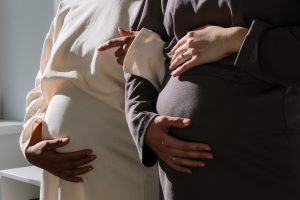Hans Sievertsen and Michelle Kilfoyle
22 November 2021
The recent demands of Covid-19 have seen hospital patient numbers soar. A better understanding of how crowding on wards affects treatments and patient outcomes is essential in helping clinicians best allocate their care – both during the pandemic and beyond, and for all sectors of hospital care. Taking maternity wards as an example, a recent Danish study of nearly 800,000 births finds that midwives adjust their care strategies for mothers to ease workload pressure during busy periods. Surprisingly, the shifts in treatment – fewer inductions and later admission to hospital – bring no obvious signs of harm to mother and child.
Evidence on the effects of crowding is scarce, especially for maternity wards. Much like A&E, maternity wards face the challenge of unpredictable admission rates that are hard to plan for. The new study, by Hans Sievertsen from the University of Bristol’s Centre for Evidence-based Public Services (CEPS) and School of Economics, starts to fill this knowledge gap for maternity wards.
Working with a team of researchers from Aarhus University and the University of Copenhagen, Sievertsen analysed birth registry and medical data for 796,416 babies born during 2000–2014 and their mothers across Denmark. They focused on uncomplicated births, thus excluding those born by planned caesarean.
The research team assessed how treatment and patient outcomes varied according to the number of patients admitted to a maternity ward for each day. Admissions can substantially and rapidly fluctuate on Danish maternity wards, and surges of 200% above the average are not uncommon.
As an example of how patient numbers vary, daily admissions on Denmark’s busiest maternity ward, Hvidovre, range between six and 25.
Their results showed that midwives appear to ease pressure on busy days by choosing not to speed-up delivery by avoiding or postponing inductions. For each three additional admissions over the average, there was a 0.7 percentage point reduction in the number of inductions. This corresponds to a 4% reduction on the average induction rate of 18.6% across all the births studied.
In addition, midwives appear to admit mothers into hospital at slightly later stages of labour during busy periods, thus reducing the overall length of time that mothers spend in hospital.
Of surprise to the research team, crowding presented no obvious health risks to either mother or baby, based on various measures of wellbeing and indicators of care.
For instance, there was no increase in stillbirths or death rates among babies within the first week and year of life. It should be noted that these are rare occurrences in any case, and the study only looked at non-risky births.
For babies, there was no effect on their APGAR score – the quick health test performed immediately after birth to assess five key factors, including breathing and heart rate.
For mothers, there was no increase in the probability of having an emergency caesarean, the rate or severity of lacerations (vaginal tearing), or delay in epidural pain relief. Skin-to-skin contact with baby within two hours of birth, a central quality indicator for Danish hospitals, continued to take place in timely fashion.
Further, children born on crowded maternity wards and their mothers were no more likely than other families to access healthcare – whether GPs or hospitals – in the two years post-birth.
In fact, the study even found that there were fewer serious post-birth complications for mothers who gave birth on busy days: a 1.5% reduction, approximately, for each three extra births over the average. The researchers speculate that this may be because the lower number of inductions on crowded days reduced the need for follow-up treatments associated with this procedure.
The study, therefore, shows that Danish maternity wards’ strategies to ease workload pressure enable midwives to cope with day-to-day spikes and dips in patient numbers, and without detectable health risks for the majority of uncomplicated births. The authors do stress, however, that their results cannot be used as evidence in support of cuts to hospital funding, as they did not examine what the optimal level of maternity care should be.


